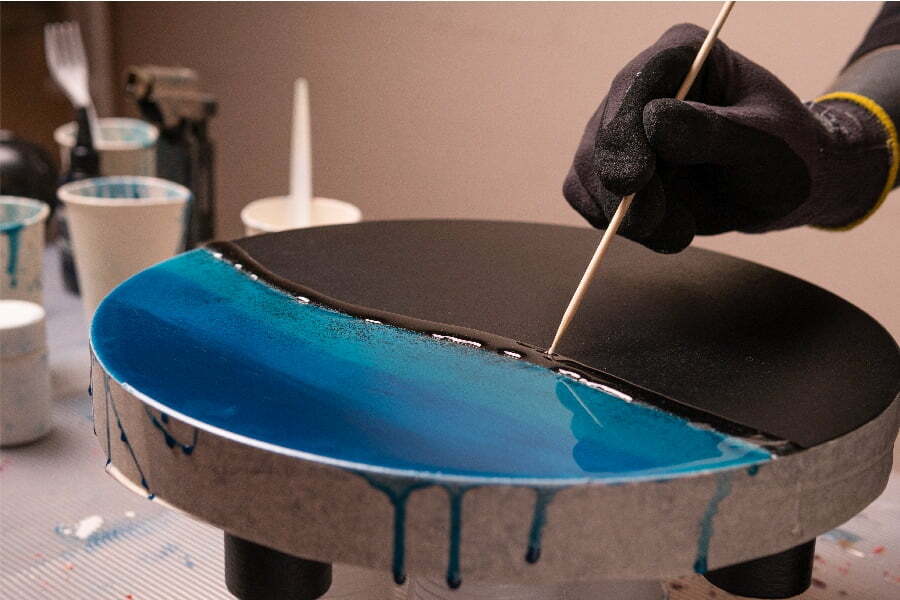Last updated on
Epoxy is a popular material that can be used for a variety of purposes due to its durability and flexibility. Here you’ll learn how to use it.
Epoxy resin is commonly used for flooring, countertops, arts and crafts, and other things. There are a lot of customization options you can explore when working with this innovative material.
Anyone can benefit from learning more about epoxy resin. This is true whether you’re new to working with epoxy resin or are looking for ways to get better at it.
Doing research beforehand helps make sure that your finished products turn out beautifully. You can also avoid making costly mistakes.
This guide will discuss our top eight helpful tips for working with epoxy resin. Become a pro when working with epoxy as you create gorgeous artwork.
Mixing Is the Most Important Step

Properly mixing your epoxy resin is the most important step in the process. You want your epoxy to have a hard-finished and glossy surface. You might be mixing your epoxy wrong if your projects have lots of bubbles or result in a mess.
Read the directions for the epoxy mixture before you get started. Make sure you have all of your tools ready to go. Some of the most common types of equipment you’ll be using include:
- Mixing buckets
- Paint sticks
- Plastic sheets
- Sandpaper
- Gloves
- Measuring cups
- Foam brushes
- Blow torch
If you’re using a mix for the first time, do a few practice batches. These test sessions help you understand how long you need to cure the epoxy.
Make Sure You Purchase Enough Epoxy Resin

Purchasing the right amount of epoxy resin is key, especially if you’re working on a large project. If you’re unsure of how much you need, this helpful deep pour epoxy calculator will help you figure out how much you need to purchase when working on creations like deep pour river tables.
Keep in mind that you’ll need less epoxy if you’re embedding materials, such as pieces of wood or rocks.
Wear Gloves

It’s important to wear gloves to protect your skin from harsh epoxy resin. However, sometimes a bit of the substance can get on exposed skin. You’ll want to avoid using harsh chemicals to remove them from your body.
Use the following steps to get resin off of your skin without using harmful ingredients:
- Pour baking soda onto the resin
- Add a small amount of dish soap to the baking soda
- Scrub your hands
- Rinse with warm water
- Repeat if needed
Keep in mind that you don’t want to add any water to the baking soda mixture. Only use water to rinse it off of your skin.
Follow Safety Rules and Procedures

While most health concerns associated with epoxy resin are minor, it’s important to practice proper safety protocol when using the product. Overexposure to epoxy resin can be hazardous to your health. This sensation typically occurs when the epoxy is in liquid form.
Sanding is an important part of using epoxy resin. However, you don’t need to worry about health hazards when epoxy hardens. That’s because it creates a non-hazardous product.
While exposing yourself to harmful chemicals is low when working with epoxy because it evaporates slowly, your risk increases if you’re experiencing one of the following:
- Confined or small workspace
- You’re heating the epoxy
- You don’t have good ventilation
There are a few steps you can take to limit your exposure to epoxy resin. These tips apply to casual and commercial epoxy users. Follow these guidelines when working with epoxy:
- Work in a well-ventilated area
- Keep your supplies in an isolated or dedicated cabinet
- Wear protective clothing, a respirator, gloves, and safety goggles
As we mentioned earlier, you’ll want to limit the contact epoxy resin has with your skin. Remove it immediately if it gets on you.
Stay Organized
Everything in your epoxy resin workspace should be easily accessible and well-organized. You should also have enough space to comfortably move around. That helps you avoid bumping into something and spilling the resin on the ground.
You should try to have a spot that’s just for working with epoxy resin. Include some of the following features in your dedicated workspace:
- A lockable room to keep small children out
- Limited distractions
- Enough light
- At least one window
- Well-organized with tools and materials
You don’t want to set up your space in an area that’s used frequently by others in your home. Avoid using your kitchen, especially since you handle food there. Your bedroom isn’t a great spot either since you don’t want to breathe in harmful substances while you sleep.
Learn How to Avoid Bubbles

Bubbles are a common problem that plagues epoxy resin users. One way to avoid encountering them is by working with a resin that’s been warmed up. This enables you to maintain the viscosity you need and ensure the epoxy can release air.
You can warm up cold epoxy resin by putting it in a bucket or bowl of room-temperature water. Allow several minutes for it to heat up.
You’ll also want to move quickly once you start working with the product. Add pigments and other items as soon as possible.
Learn the Right Epoxy Resin Mix Ratio
Adjusting the mix ratio can cause your mixture not to cure. The hardener and epoxy resin are designed to react with one another. You need to stay with the suggested mix ratio so this process happens.
For example, if there is more hardener than resin in your mixture, it won’t harden properly. The same thing happens if there’s more resin than there is a hardener.
Some Epoxies Can Yellow
UV rays can be harmful to some epoxy resins. The substance isn’t UV resistant. Your project might turn yellow if you don’t protect it from sunlight.
You can create beautiful products when you work with epoxy resin. The epoxy resin might seem intimidating, especially if you’re new to learning about it. Be patient with yourself as you learn more about how to work with this unique product.
Recap




